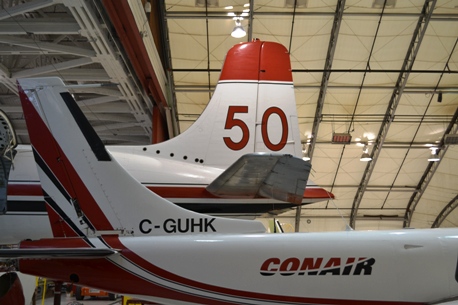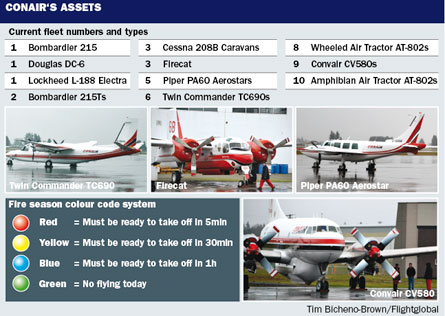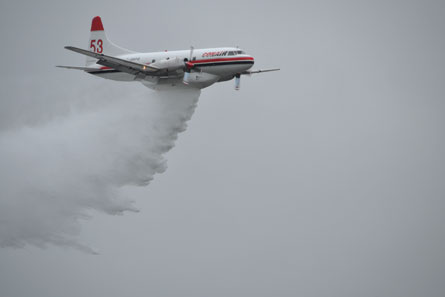British Columbia does not feel much like the place to do "spring training" for the fire season when it is 4°C (40°F), overcast and raining at 07:30 on a Monday morning. But that is exactly what was happening when Flight International visited Conair Hangar 3 at Abbotsford international airport.
Canada's largest privately owned aerial firefighting company, with nearly 50 aircraft and a workforce of 200, Conair dedicates several months every spring to getting its crews ready for the prime season - the 130 days starting in May when teams of pilots, maintainers and support staff ship out to 15 forward operating bases on long-term government contracts.
Seventy or more Conair maintenance engineers, supported by contract employees, spend the autumn and winter months performing annual inspections and original equipment manufacturer continued airworthiness instructions on the piston- and turbine-powered fleet.
Some inspections take two weeks; others can take six weeks. Transport Canada requires the firefighting fleet, which includes legacy tanker aircraft such as the Douglas DC-6, Convair CV580, Lockheed L-188 Electra and Grumman Firecat (converted S2F Tracker), to be maintained to the same levels as airline transport aircraft. Bombardier 215 and 215T tankers as well as wheeled and amphibian Air Tractor AT-802Fs round out the fleet.
Flight International was at Abbotsford on 4 April to witness the ramp-up to the season, in particular an exercise in which "bird dog" pilots would pair with CV580 pilots to practise an air drop. For its bird dogs - lead aircraft that scope out a fire in advance of the tankers - Conair uses a mix of Twin Commander 690s, Piper PA60 Aerostars and Cessna 208 Caravans.
 |
|---|
©John Croft |
Canada's Conair has close to 50 air tanker and bird dog aircraft, including the Douglas DC-6 tanker and Piper Aerostar bird dog above |
In the field, each bird dog carries a Conair pilot and a customer-supplied forestry air attack officer who assess how to fight the fire in terms of both air and ground crews. Conair's bombing systems are set up to gravity drop partial or full loads at varying rates, with lowest flow rates typically used for grass fires and faster flow rates for timber fires.
CONTRACTS
The company this year will ship its bird dog, tanker and maintenance crews to locations in Alberta and the Yukon territories in Canada, as well as in Alaska, while covering British Columbia from the Abbotsford home campus and other locations. Contracts typically range in duration from five to 10 years.
In the briefing room on 4 April, the chief pilot, ramp crew, ramp boss, flight operations co-ordinator and six others were not optimistic that the low ceilings and visibility would lift to the visual flight rule conditions required for an actual "waterbombing" run. However, the poor weather could prove to be a rich practice environment for instrument flight rule operations, the area where pilots get the most rusty in the off season.
Ground school training takes place regardless. Chief pilot Andrew Robertson, who manages 68 line pilots and five instructors, says instructors perform their ground school simulator and flight training in the autumn and go to work training the line pilots starting in March. Last to get their training are the L-188 Electra pilots and DC-6 pilots in May. Simulators in various locations are used for all models except the DC-6, Firecat, Aerostar and Air Tractors.
 |
|---|
Conair is in the process of building a two-seat mission rehearsal simulator for bird dog or tanker aircraft, featuring a 180° view forward with Microsoft Flight Simulator graphics. The system is designed to work in tandem with an air attack officer simulator operated by the British Columbia Forest Service, allowing for pilots to simulate simultaneous bird dog and tanker operations in the presence of pre-programmed fire scenarios by next year's spring training session.
Included in the simulator, which will be operational in May, is a "stall g" and speed warning system Conair developed to help pilots maintain angle-of-attack situational awareness. The system is in certification testing with Transport Canada.
The simulator is part of multi-pronged safety upgrade in the wake of a July 2010 crash of a CV580 in the mountainous interior of British Columbia. Both pilots were killed when the aircraft contacted terrain during a firebombing run. While the Transportation Safety Board of Canada has not issued its final report, Conair has been proactive with its safety programme. In addition to the simulator, Conair director of operations Ray Horton says the company improved the positioning of the emergency retardant jettison switch on bomber panels and rolled out "certain standard operating procedure calls and procedures between the flightcrew".
 |
|---|
John Croft/Flightglobal |
Conair placed emergency dump controls in more visible locations as a safety measure following a 2010 CV580 crash |
A 2006 accident, in which a Conair training pilot under contract to the Saskatchewan government crashed in a CV580, brought about a stabilised approach requirement that the aircraft be configured to land at a minimum of 500ft (150m) above ground level, says Horton. Conair, as required by Transport Canada, has a safety management system in place that includes a non-punitive reporting system.
While Robertson mulls over the weather, Twin Commander 690 instructor Guy Ridler and Justin Brooks, a "spare relief" pilot on the 690 and Cessna 208, sit down to review his bird dog flight training programme on the 690. Brooks had just returned from 8h of simulation training at FlightSafety, and would get 7h of actual flight time at Abbotsford in the coming days.
Ground school during our visit focused on operations with the CV580. Given that Conair pilots tend to stay in their jobs for many years (19 out of the 70 pilots at Conair have been there for more than 20 years), becoming a spare relief pilot, who fills in for pilots who become injured or need a break, is one way in the door in preparation for the day when a slot opens. "This is a retirement job for most of us," says Robertson.
ESCORT WORK
Unlike line pilots, who vie for certain aircraft based on a seniority system, spare relief pilots are not assigned to a particular tail number. Brooks's relief work will take place at Williams Lake in British Columbia this fire season, flying a TC690 escorting the two CV580s that will be on station there.
The official minimum time for hired pilots is 2,500h total time with 500h of multi-engine time, although Robertson says most come in with 5,000-25,000h, being either ex-airline or ex-military pilots. His progression at Conair is fairly typical for pilots - he was hired in 2003, flew the TC690 for three years, transitioned to the right seat of a CV580 and later became a captain on the wheeled AT-802F tankers.
Ridler discusses the bird dog role more with Brooks, noting that a mission starts with a high level assessment at 1,000-1,500ft AGL followed eventually by a low-level run at the tree canopy level to mark out the "drop line" for the tankers. The process takes about 10min for a small fire, which is about the time it takes for ground crews to load a tanker.
"Literally, we want [the tanker] to start at this tree and end at that tree," he says, adding that the bird dog will watch from above as the tanker does the drop. On board storage ranges from 3,100 litres (820USgal) for the AT-802F to 11,370 litres for the DC-6, carrying water (with or without foam additive), gel (water and thickening agent) or red retardant, a powder generally used around the edges of a fire. Drop lines can be as short 350m or as long as 800m, but the trick to effectiveness, says Ridler, is compensating for the wind.
"A drop that's one wingspan out is almost useless," he says. A new delivery system being certificated with Transport Canada for the Electra will deliver 12,500 litres.
 |
|---|
©John Croft |
Testing the water: a 1950s-vintage CV580 performs a drop over the Abbotsford runway |
His background includes flying a de Havilland DHC-5 Buffalo for the Canadian air force before coming to Conair in 2005, where he first flew the DC-6 and CV580 tankers then moved on to bird dogs. He cites pay and the flexibility allowed by a 130-day work year as the good points of the job.
The down side can be "the stress leading up to leaving here" for the long fire season away from home and family, and where three days holiday a month is the norm. During the day, flying will usually start around 11:00 or noon, which corresponds to the "hottest and most aggressive part of the day in terms of the fire", he says. Pilots are limited to flying 8h in one day, but the working day can end as late as 22:00 in June and July.
TELECONFERENCE CALLS
From a management perspective, Conair keeps the troops synchronised with weekly teleconference call to all 15 bases. For his part, Robertson spends 90% of his time during the fire season visiting bases, filling in or flying "when a guy needs a day off". Not that all Conair pilots are "guys" - there is one female pilot among the ranks, a CV580 first officer with more than 10 years in the company.
With low ceilings stubbornly hanging on, and forecasters predicting more of the same for the rest of the day, Robertson was forced to cancel the bird dog/CV580 tie-up (which I was to watch in action from a second bird dog piloted by Horton), but sends Chris Baldwin, a CV580 check and training captain, out with line pilot Jeff Brousseau to undergo local IFR training.
On board C-GKFO, a 1950s-vintage CV580, Baldwin and Brousseau discussed the mission at hand, a local IFR training mission using the Hope One instrument arrival back into Abbotsford. After discussing the en route portion, the men practised their cockpit resource management skills, reviewing possible take-off anomalies and corresponding actions and reactions by each pilot. The mission would include a load of 7,960 litres of water.
While I could not fly in C-GKFO for insurance reasons, Baldwin and Brousseau did perform a water drop over the runway at a drop rate of "2", a relatively slow rate that would paint the sky white over half the runway at Abbotsford, in part for my viewing pleasure. The pilots did not disappoint.
 |
|---|
©John Croft |
A Lockheed Electra is being kitted out with 12,500 litre tanks |
Watch video from John Croft's Conair visit, posted to his blog At the Cro(ft) Flies.
ENDLESS SUMMER
Decades-old aircraft with industrial roles will only last so long, especially when powered by piston engines. The quandary has been a top item of concern for the US Forest Service, operator of the largest civil aerial firefighting fleet in the world, for many fire season summers running.
The "turmoil" with the fleet started nearly a decade ago, says Tom Harbour, director of fire and aviation management for the US Forest Service (USFS), "when the wings folded" on a Lockheed Martin C-130A on a mission in California in 2002. Then a Consolidated PB4Y exploded in mid-air in Colorado. "After decades of operating in a fashion we thought was appropriate, we woke up to a very different situation," he says. "The outcome, effect and impact of those accidents and tough, controversial decisions the government had to make to this day retain resonance."
Harbour's fleet of available large air tankers would decrease from 44 then to 18 now. Today's fleet is a mix of ageing P2V Neptune and P3 Orions. And while the safety concerns may well be controlled by continued airworthiness instructions, at some point the cost outweighs the benefit.
"The two operators of the P2V have told us they will become too expensive to fly over the next two years," says Harbour. The Fire Service can have 700 firefighting aircraft in the air at a time and works 10,000 fires a year on average.
MAINTENANCE
Canada's Conair is seeing similar pushback from customers north of the border on maintenance expenses. The company's trademark piston-powered variant of the Grumman S2 tracker, the Firecat, is quickly going the way of the P2V. Peter Boniface, director of maintenance for the Abbotsford, British Columbia-based company says its not only the difficulty in finding parts and the decreased reliability of pistons compared with turbines, but the difficulty operators have finding avgas. "We were supposed to retire [our three Firecats] last year and didn't," says Boniface. "Now it's this year."
Conair has one vision for the future of large tankers however - its modified Bombardier Q400-MR tanker. With its sister company Cascade Aerospace, Conair engineers developed a supplemental type certificate for the conversion and delivered two to the French government in 2005. Others see newer generation very large air tankers, available in the form of 10 Tanker McDonnell Douglas DC-10s and Evergreen Boeing 747s, as part of the solution. Rick Hatton, 10 Tanker chief, says he has flown 355 missions to date, working 50-plus fires, mostly in California.
Smaller firefighting aircraft, at least for surveillance functions, may go the way of the unmanned air vehicle. A new contract issued by the USFS calls for as much as $750,000 over the next three years to demonstrate small UAVs for day and night fire surveillance. Harbour says lawmakers in Washington are also interested in UAVs that could carry 7,580-19,000 litres (2,000-5,000USgal).
Source: Flight International
















